*NURSING > QUESTIONS & ANSWERS > NURSING 01 HESI ENTRANCE EXAMINATION STUDY GUIDE TABLE OF CONTENTS (All)
NURSING 01 HESI ENTRANCE EXAMINATION STUDY GUIDE TABLE OF CONTENTS
Document Content and Description Below
NURSING 01 HESI ENTRANCE EXAMINATION STUDY GUIDETABLE OF CONTENTESPage HESI Study Packet Introduction HESI Test Overview (Math, Reading, Comprehension, Vocabulary, Grammar) Math (face sheets pr... ecedes each section—pages bold, underlined; Answers follow each section Math diagnostic Test HEST Math Review I-III: Add, subtract, multiply, divide Math IV-VI: Add, subtract, multiply, divide decimals Math VII-XII: Fraction terms; reducing proper and improper fractions; LCD changing improper to mixed, mixed to improper; ass, subtract, multiply, divide fractions; change fractions to decimals; change decimals to fractions Math XIII: Ratio/Proportion Math XVI: Percentages Math: Helpful information to memorize and understand: chart of fractions, decimals, percents; Roman numerals; measurement conversions Math Review Answer key MATH PRACTIVE TEST 1 (face sheets) 1. Add, subtract, multiply, divide 2. Multiply, divide (by & into), and, subtract decimals 3. Change fractions to decimals; decimals to fractions 4. Add, subtract, multiply, divide fractions 5. Percentage 6. Ratio/Proportion 7. Conversion 34-36 37-39 40-41 42-43 44-46 47-48 49-50 51-52 53-54 55-56 57 58-59 3-4, 5-8 9-14 15-19 20-33 1-28.Rounding 60-61 MATH PRACTICE TEST 2 (face sheets) 9. Add, subtract, multiply, divide 10. Change decimals to fractions; change fractions to decimals; multiply, divide (by & into) add, subtract decimals. 11. Add, subtract, multiply, divide fractions 12. Percentage 13. Ratio/Proportion 14. Conversion 15. Rounding Reading Comprehension (face sheets) face sheet precedes each section pages are bold, underlined; answers follow each section How to answer reading comprehension questions and sharpen your reading skills (without really trying) Sample reading test Reading Vocabulary (face sheets) face sheet precedes each section pages are bold, underlined; answers follow each section 1. Test 5 (everyday) 2. Exams 7, 10-14 (everyday) 3. Spelling (everyday) 4. Multiple Choice Quiz (medical terminology) Chapter One- Four, Twenty-One List of medical terminology (four study only) Grammar (face sheets) face sheet precedes each section- pages are bold, underlined; answers follow each section 1. Exercise One: Problems with Verbs (Part 1) 93-95 96-97 98-102 103-107 108-122 123-134 135-137 138-139 62-64 65-66 67-68 69-70 71-72 73-74 75-76 77-78 79-80 81-83 84-86 87-922. Exercise Two: Problems with Verbs (Part 2) 3. Exercise Three: Problems with Verbs (part 3) 140 141 4. Exercise Fourteen: Problems with Introductory Verbal Modifiers 5. Exercise Fifteen: Problems with Parallel Structure 6. Exercise Eighteen: Problems with Structure Answer keys for above grammar section (1-6) 7. Lesson 5: Sentence Structure: Dangling Modifiers 8. Lesson 5: Sentence Structure: Parallel Structure Answer keys for above grammar section (7-8) 9. Plurals: Ex 2, 3, 4, 5 10. Verbs: Ex 12, 13 Answer keys for above grammar section (9-10) 11. Verbs: (Subjects – Verbs Agreement) lesson 12, Exercise 19 Answer key for the above grammar section (11) 12. Gerunds and Infinitives Answer key for above grammar section (12) 142-144 145-147 148-149 150-158 159-161 162-164 165 166-169 170-172 173-174 175-178 179-180 181 1821 Math Overview Types of questions (no word or story problems) 1. Add, subtract 2. Add, subtract: decimals, whole numbers to decimals 3. Ratio; change fractions to ratio 4. Change decimal to percent 5. Multiply decimals 6. Divide by decimals 7. Rounding 8. Change fractions to decimals 9. Divide by fractions 10. Reduce 11. Add fractions with unlike denominators 12. Divide fractions by whole numbers 13. Divide fractions by fractions HESI Reading Comprehension Overview 1. Need a good vocabulary to answer questions 2. Read, summarize 3. Implies information: Ex. (From the text) In a test, spend more time on essay questions, which are worth more. (From the question) In a test, in order to get more points, spend more time on difficult questions. 4. Long and short paragraphs 5. Other types of questions: A. Definition of words B. What is stated vs. implied C. Fact vs. opinion HESI Vocabulary Test Overview 1. Vocabulary in context, or as definition, or correct usage---questions not always clear A. Multiple Choice, Scenario is set up B. Medical terms, some from biology C. Literary words D. Everyday words2 HESI Grammar Overview 1. Particularly difficult for ESL (foreign) students 2. Questions 1-25 select best answer A. Verb Forms B. Dangling modifiers 3. Questions 26-50 Identify and correct incorrect portion a. Subject-Verb agreement b. Parallelism c. Plurals d. Infinitives (to + Verb) or Gerunds (verb + ing) e. Particles/prepositions (depend on, not depend in) f. There, their, they’re usage 4. Questions 51-553 MATH Diagnostic Directions: 1) Take the diagnostic test that follows. 2) Score with the answer key that immediately follows. 3) Provide the following information hereon (pages 3,4) for tutor- and-self- evaluation: Total number of problems: 27 Number correct: Multiply number correct X 100= Divide by total number of problems= % Tutor will review for areas to work on in Math. Areas to work on: , , , NEXT STEP: GO ON TO MATH REVIEW, THEN PRACTICE TESTS 1 AND 2.4 Diagnostic Key to follow Circle question number (s) missed 1 Type of Question Addition 2 5 3 6 4 7 8 9 10 11 12 16a 17 18 19 13 14 15 16b 21 22 23 24 25 26 27a 27b Multiply decimals Divide by decimals Percent problem Ratio Problem Concept of ratio Subtract decimals Multiply fractions Divide fractions Multiplication Division Subtraction Add, subtract, multiply, decimals Concept of decimals, fractions, percent Add fractions w/ unlike denominators5 Number Power Review Pretest This pretest will tell you which chapters of Number Power Review you need to work on and which you have already mastered. Do all the problems that you can. There is no time limit. Check your answers with the answer key. Fill out chart at test end. Do all work on these pages. Find an answer to each problem 1. 793 2. 215 x 89 = 3. 417 19 517 + 385 Find an answer to each problem. 4. 2800 - 946 5. 173 x 26 6. 4,208 16 7. Find the Value of the expression: 3 ($2.50 - $1.00) + ($10.00 4). 8. Write the following numbers in order, from least to greatest. 3 .034 4 9. What percent of this pizza has been eaten? 30% 2 3 4% 0.46 Write <, > or + to compare each pair of numbers. 10. 3 21 8 48 Solve each Problem. 13. 2 ¾ +1 ⅓ 14. 2 x 3 3 5 15. 1 5 4 8 16. Keisha bought sixteen cans of soda for a birthday party. Six of these are cans of cola. a. What fraction of the soda is cola (red)? = Red 11. 4 2 14 3 12. 3 4 2 2 11 5 15 b. What is the ratio of cola to flavors that are not cola? Write <,>, or = to compare the pair of decimals. 17. 0.65 0.605 18. 0.329 0.48 20. Which expression can be used to find the width of each board? Board gap 0.375 18” a. 18+ (3 x 0.375) 4 b. 18+ (3 x 0.375) 3 c. 18- (3 x 0.375) 3 d. 18-(3 x 0.375) 4 e. 18 –(4 x 0.375) 4 19. 1.14 1.0427 Solve each problem. 21. 5.08 -2.92 24. The Clothes Tree is offering a 25% discount on all women’s sweaters. Including a 6% sales tax, what will Selena pay for a sweater that normally sells for $48.00? For problem 25 & 26, refer to the circle graph. 25.What percent of the students at Highland Middle School are in the 8th grade? 26. Suppose that next year the enrollment at Highland Middle School increases by 20%. How many students will be enrolled at Highland next year? 22. 2.05 x 0.06 = 23. 2.842 1.4 = 7th 6th Grade 174 Grade 156 8th Grade 170 27. What is the ratio of the amount that Jonathan saved in May to the amount he saved in January? (Reduce to lowest terms. If necessary) If Jonathan’s take-home pay is 1,500 per month, how much did he save during the 6 months shown on the graph? 30 25 20 15 10 5 0 Jan Feb Mar Apr May Jun8 Answer Key 1. 1,695 2. 19,135 3. 21 R 18 4. 1,854 5. 4,498 6. 263 7. $ 7.00 ($4.50 + $2.50) 8. 4%, 30%, 0.34, 0.4, 2/3, ¾ 9. 62.5% 10. < 11. = 12. > 13. 4 – ½ 14. 2/5 15. 2/5 16. a. 3/8 (6/16) b. 3/5 or 3 to 5 (6/10) 17. > 18. < 19. > 20. d. 21. 2.16 22. 0.123 23. 2.03 24. $38.16 ($36.00+ $2.16) 25. 34% (170/500 x 100%) 26. 600 (500 + 100) 27. 5/3 (25/15)9 Math Review (Note: This page has space for portion and for overall test score.) Directions: 1) Take the portion of the test that follows. Label and do all work on front and back of same page as problem. 2) See pages 42-44 for answer key, to score portion. 3) Provide the following information hereon (page 10) for tutor- and self- evaluation: Total number of problems: 24 Number correct: Add, subtract, multiply, divide, whole numbers Multiply number correct X 100 = Divide by total number of problems = Tutor will review for areas to work on in math. Areas to work on: , OVERALL MATH REVIEW SCORE Total number of problems (overall): 104 Number correct: Multiply number correct X 100 = Divide by total number of problems = Tutor will review for areas to work on in math. Areas to work on: , % % , , , , NEXT STEP: GO ON TO PRACTICE TESTS 1 AND 2.10 Basic Addition 462+133 Basic Addition and Subtraction Steps: 462 +133 595 Addition w/ Regrouping 835+559 1 835 + 559 1394 Basic Subtraction 5,234 – 4,112 5,234 - 4,112 1,122 Check by: 1,122 +4,112 5,234 must be the answer Check by: 1,394 - 599 835 must be the answer Check by: 595 - 133 462 must be the answer 1. Line up digits according to place value. 2. Add the digits starting from right to left: Ones: 2 + 3 = 5 6 + 3 = 9 Tens: Hundreds: 4 + 1 = 5 Steps: 1. Line up the digits according to place value. 2. Add: Ones: 5+9 = 14 (carry the 1 to the tens place, which is one place to the left) Tens: 1+ 3+ 5= 9 Hundreds: 8+ 5= 13 Steps: 1. Line up the digits according to place value. 2. Subtract: Ones: 4 – 2 = 2 Tens: 3 – 1 = 2 Hundreds: 2 – 1 = 1 Thousands: 5 – 4 = 1Subtraction with Regrouping 457 – 29 4 1 7 4 5 7 - 2 9 4 2 8 Check by: 428 + 29 457 must be the answer Steps: 1. Line up the digits according to place value. 2. Subtract: Ones: 7 – 9 (must borrow 1 from the 5 In the tens place) Tens 4 – 2 = 2 Hundreds: 4 – 0 = 4Vocabulary: Digit: A numeral, (the number 7 is a digit). Place Value: Each digit in a number occupies a position – that position is called its place value. HESI Hints: 1 Ten = 10 ones 1 Hundred = 100 ones 1 Thousand = 1000 ones 2. 835 + 145 = 3. 1,372 + 139 6 5 9 4. 123 + 54 + 23 = 5. 673 – 241 = 6. 547 – 88 = 7. 222 – 114 = 8. 12,47 8 – 467 = Now you try! 1. 1,803 + 156 = Hundred Tens Ones11 Basic Multiplication (Whole Numbers)23 X 5 1 2 3 x 5 11 5 623 X 45 62 3 x 45 3115 24,92 0 28,03 5 Steps: 1. Multiply one digit at a time. 2. Multiply (5 X 23) Ones: 5 x 3 = 15 (carry the 1 to the tens place and write the 5 in the ones place) Tens: 5 x 2 = 10 + 1 = 11 Steps: 1. Multiply 623 X 5 5 x 3 = 15 5 x 2 = 10 + 1 (carried over)= 11 5 x 6 = 30 + 1 (carried over)= 31 (doesn’t need to be carried over) 2. Multiply 623 x 4 (remember to line up the ones digits with the four by using zero as the placeholder): 4 x 3 = 12 4 x 2 = 8 + 1 = 9 4 x 6 = 24 3. Add the two products together: 3,115 + 24,920 = 28,035 is the final product Vocabulary: Product: The answer to a multiplication problem. HESI Hints: Remember, the placeholders help keep the problem aligned. If you do not skip a space, the answer will be incorrect. Below is an example of a well-aligned problem. Note: Timetables are crucial for doing multiplication, division, fractions, etc. Please notify the tutor if you do not know timesheets by heart at least through 9 x 9.12 30 1 301 x 451 x 451 301 15050 +120400 135,751 Steps: Now You Try! 1. Multiply 301 x 1 ¾ 1 x 1 = 1 ¾ 1 x 0 = 0 ¾ 1 x 3 = 3 2. Multiply 301 x 5 ¾ 5 x 1 = 5 ( remember to use a zero for a placeholder) ¾ 5 x 0 = 0 ¾ 5 x 3 = 15 3. Multiply 301 x 4 ¾ 4 x 1 = 4 ¾ 4 x 0 = 0 ¾ 4 x 3 = 12 4. Add the three products together: ¾ 301 + 15,050 + 120,400 = 135,751 is the final product 5. 795 x 14 = 6. 999 x 22 = 7. 582 x 325 = 8. 9,438 x 165 = 4. 806 x 55 = 2. 325 x 6 = 3. 653 x 12 = 1. 846 x 7 =13 Basic Division (Whole Numbers) 40 8 = Steps: 1. Set up the problem. (Review the vocabulary section). 2. Use a series of multiplication and subtraction problems to solve a division problem. 3. 8 x ?= 40 Multiply: 8 x 5 = 40 Subtract: 40-40=0 The quotient (or answer) is 5 672 6 = Steps: 1. Set up the problem. 2. Begin with the hundreds place: o 6 x ?=6; we know 6 x 1 =6; Therefore, place the 1(quotient) above the 6 hundred (dividend). Place the other 6 under the hundred and subtract: 6-6=0 o Bring down the next number which is 7; 6 x ? = 7. There is no number that can be multiplied by six that will equal seven exactly, so try to get as close as possible without going over 7. Use 6x1=6 and set it up just like the last subtraction problem. 7-6 =1 o Bring down the 2 from the dividend which results in the number 12 (the 1 came from the remainder of 7-6=1). o 6x?=12;?=2 The two becomes the next number in the quotient. 12- 12=0. There is not a remainder. o The quotient (or answer) is 112. Vocabulary Quotient: The answer to a division problem. Dividend: The number being divided. Divisor: The number by which the dividend is divided. HESI Hints: The 5 represents the divisor, the 45 represents the dividend, and the 9 represents the quotient. It is the best not to leave a division problem with a remainder, but to end it as a fraction or a decimal point instead. To make the problem into a decimal, just add a decimal point and zeros at the end of the dividend and continue. If a remainder continues to occur, round to the hundredths place. Example: 233.547 233.55 (the 7 rounds the 4 to a 5) Steps to Division 1. Division 2. Multiplication 3. Subtraction 4. Bring down14 174 5 Steps: 1. Set up the problem. 2. 5 does not divide into 1, but does divide into 17. 3. 5 x 3 = 15 Write the 3 in the quotient. (It is written above the 7 in seventeen because that is the last digit in the number). o 5 x 3 = 15 o 17 – 15 = 2 4. Bring the 4 down. Combine the 2 (remainder from 17-15) and 4 to create 24. 5. Five does not divide evenly into 24; therefore try to get close without going over. o 5 x 4 = 20 o 24 – 20 =4 6. There is a remainder of 4, but there is not a number left in the dividend. Add a decimal point and zeros and continue to divide. 7. The quotient (or answer) is 34.8 (thirty-four and eight tenths). Now You Try! 1. 132 11 = 2. 9,618 3 = 3. 2,466 2 = 4. 325 13 = 5. 5,024 8 = 6. 3,705 5 = 7. 859 4 = 8. 6,987 7 =15 Math Review Directions: 1) Take the portion of the test that follows. Label and do all work on front and back of same page as problem. 2) See pages 42-44 for answer key, to score portion. 3) Provide the following information hereon (page 16) for tutor-and-self- evaluation: Total number of problems: 16 Number correct: Add, subtract, multiply, divide decimals Multiply number correct X 100 = Divide by total number of problems = Tutor will review for areas to work on in math. Areas to work on: , , % , Next step: Go to Math Review, Then Practice Tests 1 & 216 2.6 + 3.1 2.6 + 3.1 5.7 5 + 12.34 12.34 + 5.00 17.34 Addition and Subtraction of Decimals Vocabulary: Steps: 1. Line up the decimal points. 2. Add the tenths together: 6 + 1 = 7 3. Add the ones together: 3 + 2 = 5 4. Final answer: 5.7 (5 and 7 tenths). Steps: 1. Line up the decimal points. o It might be difficult to line up the Example: 5= 5.00 5 because it does not have a decimal point. Remember that after the ones place; there is a decimal point. IN order to help with organization, add zeros. 2. Add the hundredths: 4 + 0 = 4 3. Add the tenths: 3 + 0 = 3 4. Add the ones: 2 + 5 = 7 5. Add the tens: 1 + 0 = 1 6. Final answer: 17.34 (17 and 34 hundredths). 7.21 – 4.01 7.21 - 4.01 3.20 12 – 8.99 Steps: 1. Line up the decimal points 2. Subtract the hundredths: 3. Subtract the tenths: 2 – 0= 2 4. Subtract the ones: 7 – 4 = 3 5. Final answer: 3.20 (3 and 20 hundredths). Steps: 1. Line up the decimal points. 2. Since twelve is a whole number, add a decimal point and zeros. 3. .00 - .99 cannot be subtracted; 1 9 10 12.00 - 8.99 3.01 therefore, 1 must be borrowed from the 12 and regrouped. 4. The ones become 1, the tenths become 9, and the hundredths become 10. 5. Subtract the hundredths: 10 – 9 = 1 6. Subtract the tenths: 9 – 9 = 0 7. Subtract the ones: 11 – 8 = 3 o 1 was borrowed from the tens in order to subtract the 8. Final answer: 3.01 (3 and 1 hundredth). 8. 21.36 – 8.79 = 5. 8.5 + 7.55 + 14 = 6. 18 + 7.55 = 7. 31.84 – 2.430 = 2. 2.258 + 64.58 = 3. 892.2 + 56 = 4. 22 + 3.26 = HESI Hints: The word “and” when writing the number in words stands for the decimal. Example: 5.7 (five and seven tenths) Now You Try! 1. 9.2 + 7.55= 9 8 7 6 . 5 4 3 2 Place value (regarding decimals): Numbers to the right of the decimal point have different terms from the whole numbers to the left of the decimal point. Each digit in a number occupies a position; that position is called its place value. Thousands HundredsTensOnes Tenths HundredthsThousandths Ten-Thousandths17 Multiplication of Decimals75.7 x 2.1 75.7 x 2.1 757 +15140 158.97 1 decimal place + 1 decimal place 2 decimal places move to two the left decimal places in the final product. Steps: 1. Multiply 757 x 21 (do not worry Vocabulary: about the decimal until the final product has been calculated). Place value (regarding decimals): Numbers to the right of the decimal point have different 2. Starting from the right count the decimal places in bo h numbers terms from the whole numbers to the left of and ass together (2 decimal places). the decimal point. 3. Move to the left 2 places and then place the decimal. Each digit in a number occupies a position: That position is called its place value. 0.002 x 3.4 x 0.002 3.4 0008 + 00060 0.0068 3.41 x 7 x 3.41 7 23.87 2 decimal places + 0 decimal places 2 decimal places Move two places to the left. 3 decimal places + 1 decimal places 4 decimal places Move four places to the left. 3. Steps: 1. Multiply 0002 x 34 2. Starting from the right, count the decimal places in both numbers and add together (4 decimal places). Move to the left 4 places and then place the decimal. 9 8 7 6 . 5 4 3 Steps: 1. Multiply 341 x 7 2. Starting from the right, count the decimal places in both decimal places). Now you Try! 1. 0.003 x 4.23 = 2. 98.26 x 8 = 3. 8.03 x 2.1 = 4. 250.1 x 25 = 5. 0.1364 x 2.11 = 6. 8.23 x 4 = 7. 0.058 x 64.2 = 8. 794.23 x .001 = numbers and add together (2 3. Move to the left 2 places and then place the decimal. ThousandsHundredsTensOnes TenthsHundredthsThousandths18 Division of Decimals 34 2.5 Steps: 1. Set up the division problem. 2. Move the decimal point in 2.5 Vocabulary: Quotient: The answer to a division problem. one place to the right making Dividend: The number being it a whole number. divided. 3. “What is done to one side must be done to the other side.” Move the decimal point one place to the right in 34, making it 340, and then bring the decimal point up into the quotient. 4. Divide normally: o 25 x 1= 25 o Subtract 34 – 25 = 9 Divisor: The number by which the dividend is divided. The 5 represents the divisor, the 45 represents the dividend, and 9 represents the quotient. Place value (regarding decimals): Numbers to o Bring down the zero to make the right of the decimal point have 90 different terms than whole o 25 x 3 = 75 This is as close to 90 as possible without going over o Subtract 90 – 75 = 15 o Add a zero to the dividend and bring it down to the 15 making it 15j0 o 26 x 6 = 150 150 – 150 = 0 5. The quotient is 13.6 2.468 0.2 Steps: 9 8 7 6 . 5 4 3 2 HESI Hints: 1. Set up the division problem. The number 25 is a whole number. 2. Move the decimal point in Though this number could be 0.2 over one place to the right making it a whole number. .02 is now 2. 3. Move the same number of spaces in the dividend. 2.468 is now 24.68. 4. Bring the decimal point up to the quotient in the new position. 5. Divide normally. written 25.0, decimals are usually not displayed after a whole number. numbers. ThousandsHundreds Tens Ones TenthsHundredthsThousandths Ten-Thousandths19 0.894 0.05 Steps: 1. Set up the division problem. 2. Move the decimal point in the divisor until it is a whole number. 0.05 is now 5 3. Move the decimal in the dividend the same amount of spaces that were moved in the divisor. 0.894 is now 89.4 4. Divide normally. 5. 2.6336 0.32 = 6. 591 0.3 = 7. 0.72 0.8 = 8. 0.132 0.11 = Now You Try! 1. 48 0.4 = 2. 144 0.6 = 3. 3.75 0.4 = 4. 56.2 0.2 =20 Math Review Directions: 1) Take the portion of the test that follows. Label and do all work on front and back of same page as problem. 2) See pages 42-44 for answer key, to score portion. 3) Provide the following information hereon (page 21) for tutor-and self- evaluation: Total number of problems: Number correct: 48 Fractions Multiply number correct X 100= Divide by total number of problems= % Tutor will review for areas to work on in math. Areas to work on: , , +- ,Next step: Go to Math Review, Then Practice Tests 1 & 221 Basic Fraction Vocabulary and Explanation (terms, improper fractions, reducing, least common denominators, and mixed numbers) Terms Numerator (part) Denominator Fraction Bar Example: 21 is solved using division 7 (The top number goes inside the box. The bottom number goes outside the box.) The answer is 3. Reducing Fractions using the Greatest Common Factor Reduce Factors of 7 and 21: 7 {1,7} 21{1,3,7,21} The greatest common factor is 7; therefore divide the numerator and denominator by 7. 7 7 = 1 21 7 = 3 Reduce Factors (all represent a half) (reducing fractions can also be called reducing a fraction to its lowest terms or simplest form.) of 12 and 20: 12 {1, 2, 3, 4, 6, 12} 20 {1, 2, 4, 5, 10, 20} The greatest common factor is 4 (they do have 1 and 2 in common, but the greatest factor is needed). 12 4 = 3 20 4 = 5 1= 1 , 2 , 3 , 4 , 5 , 6 , 7 , 8 , 9 , 10 1 2 3 4 5 6 7 8 9 10 Description: o The n [Show More]
Last updated: 1 year ago
Preview 1 out of 249 pages
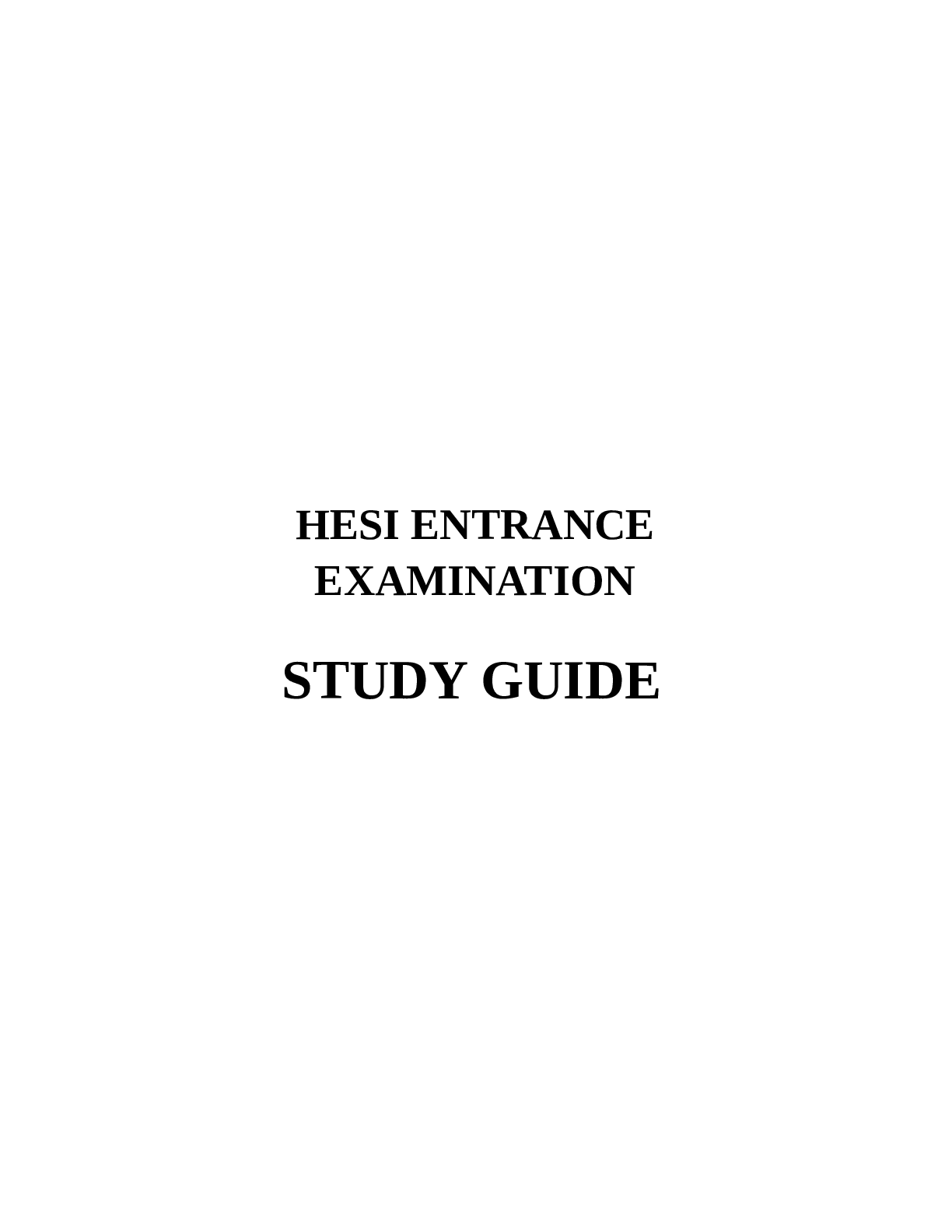
Reviews( 0 )
Document information
Connected school, study & course
About the document
Uploaded On
Sep 08, 2021
Number of pages
249
Written in
Additional information
This document has been written for:
Uploaded
Sep 08, 2021
Downloads
0
Views
51


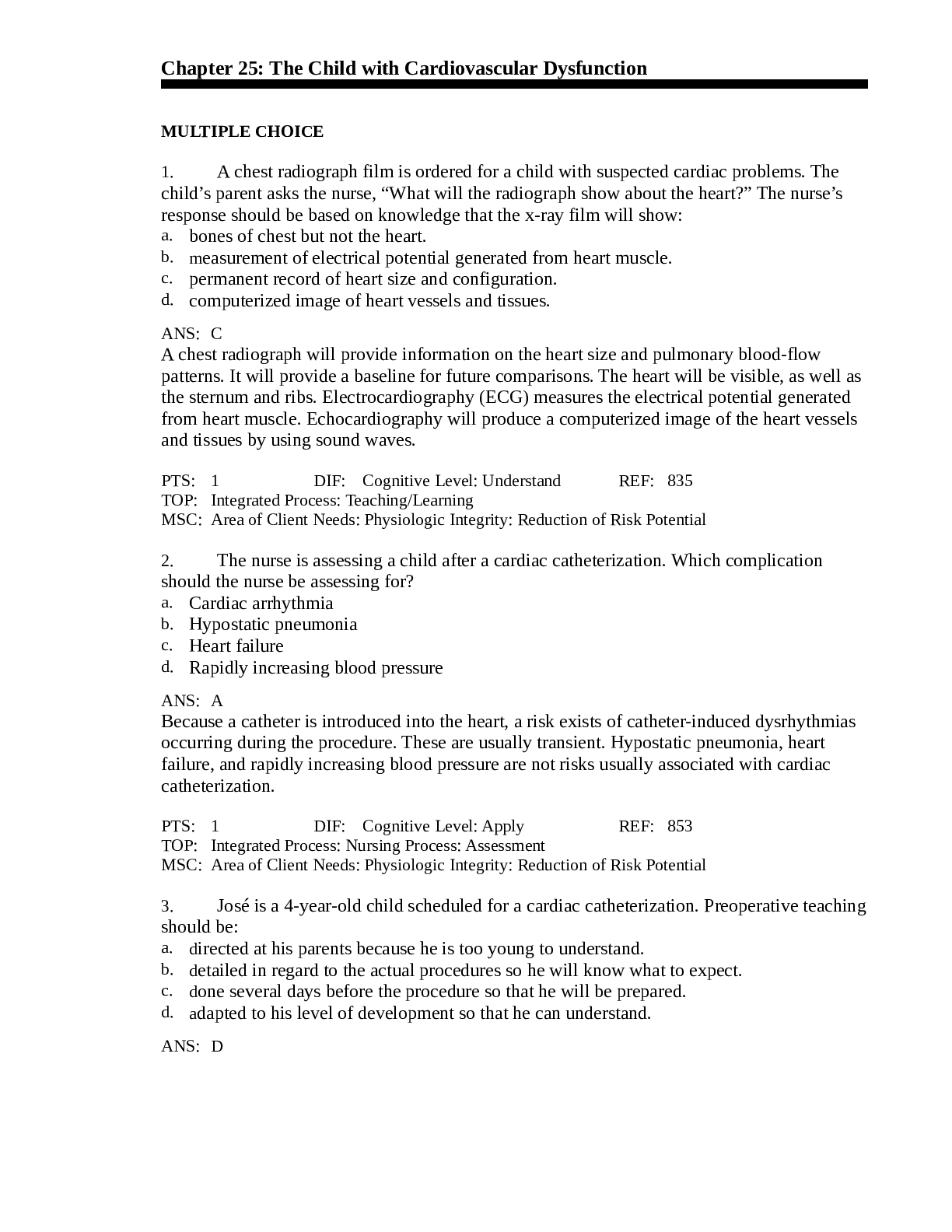
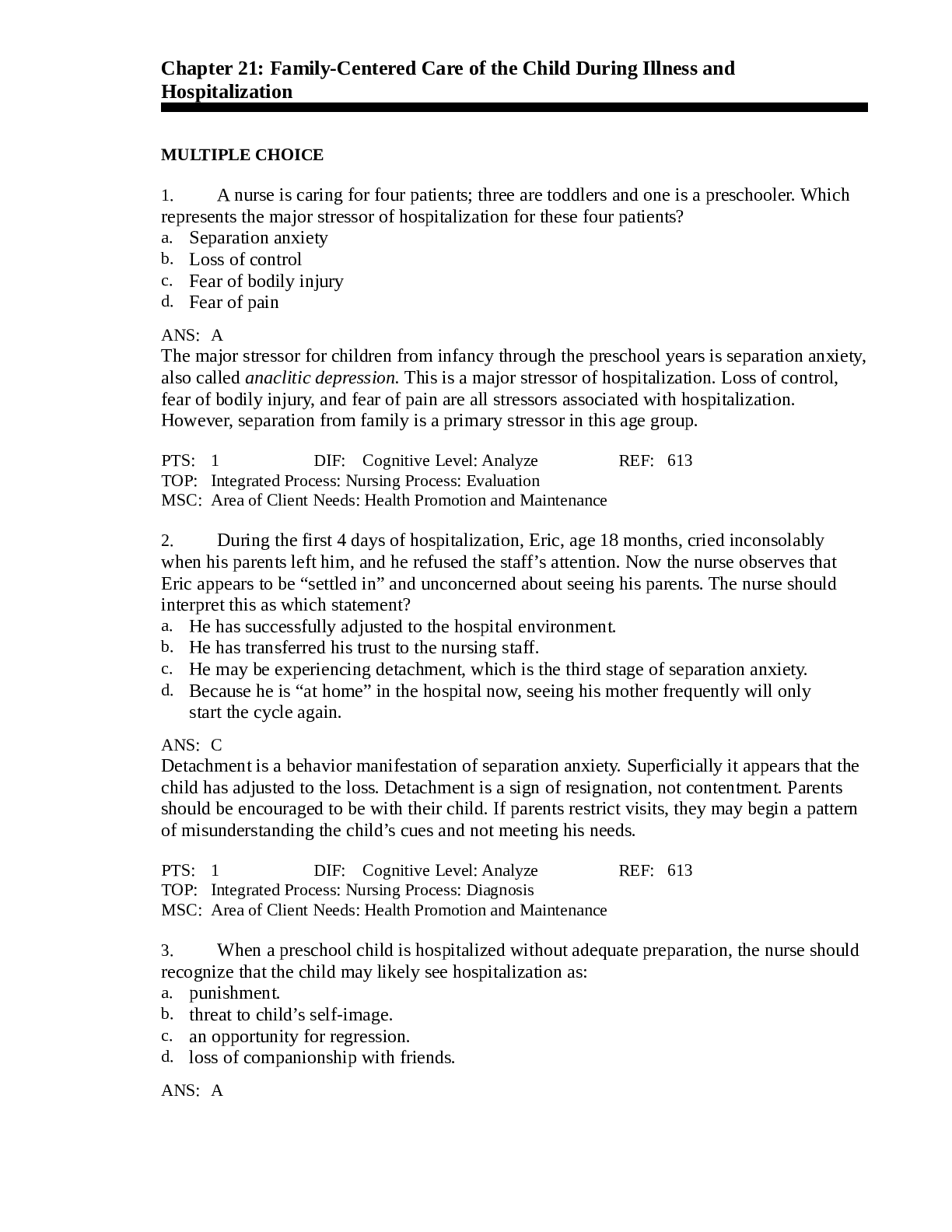
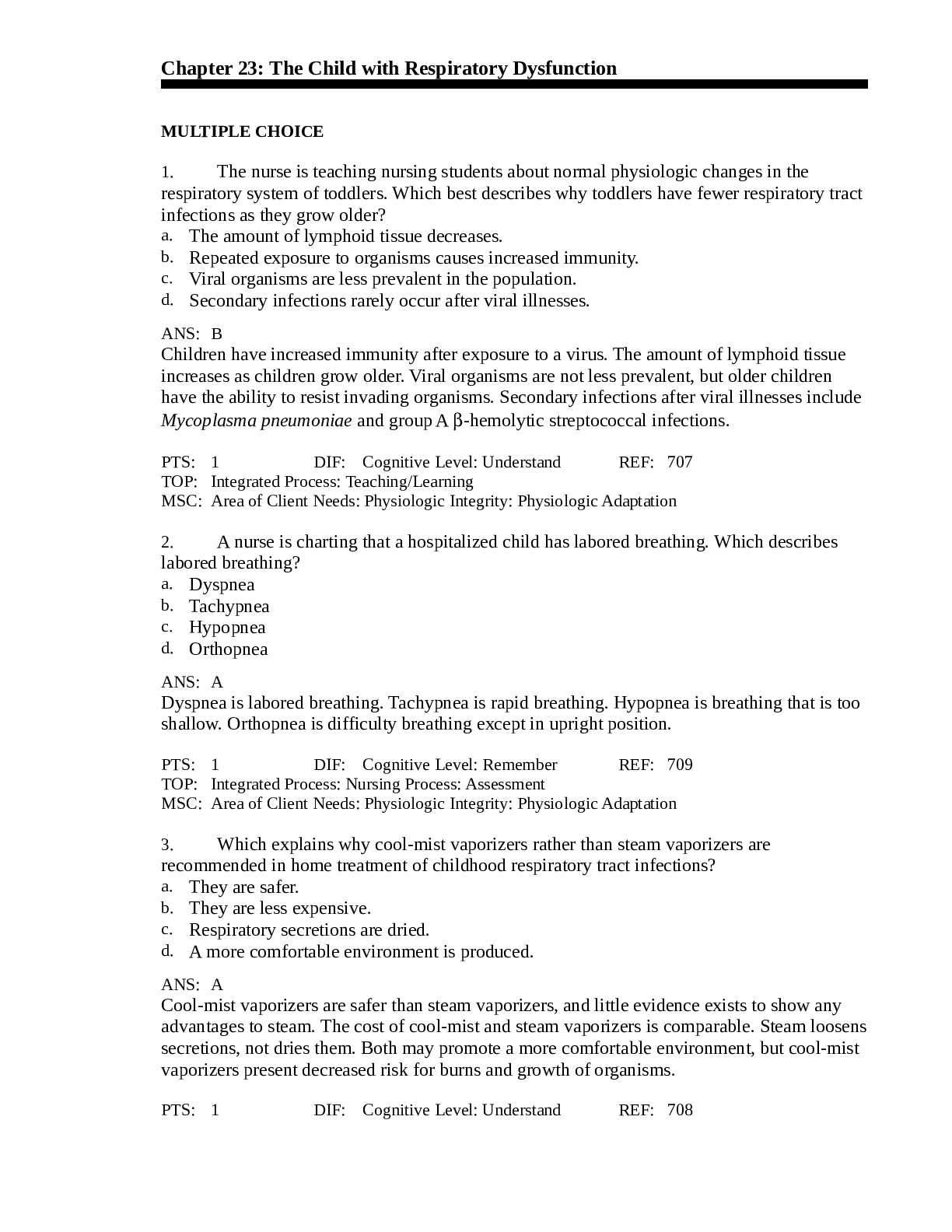
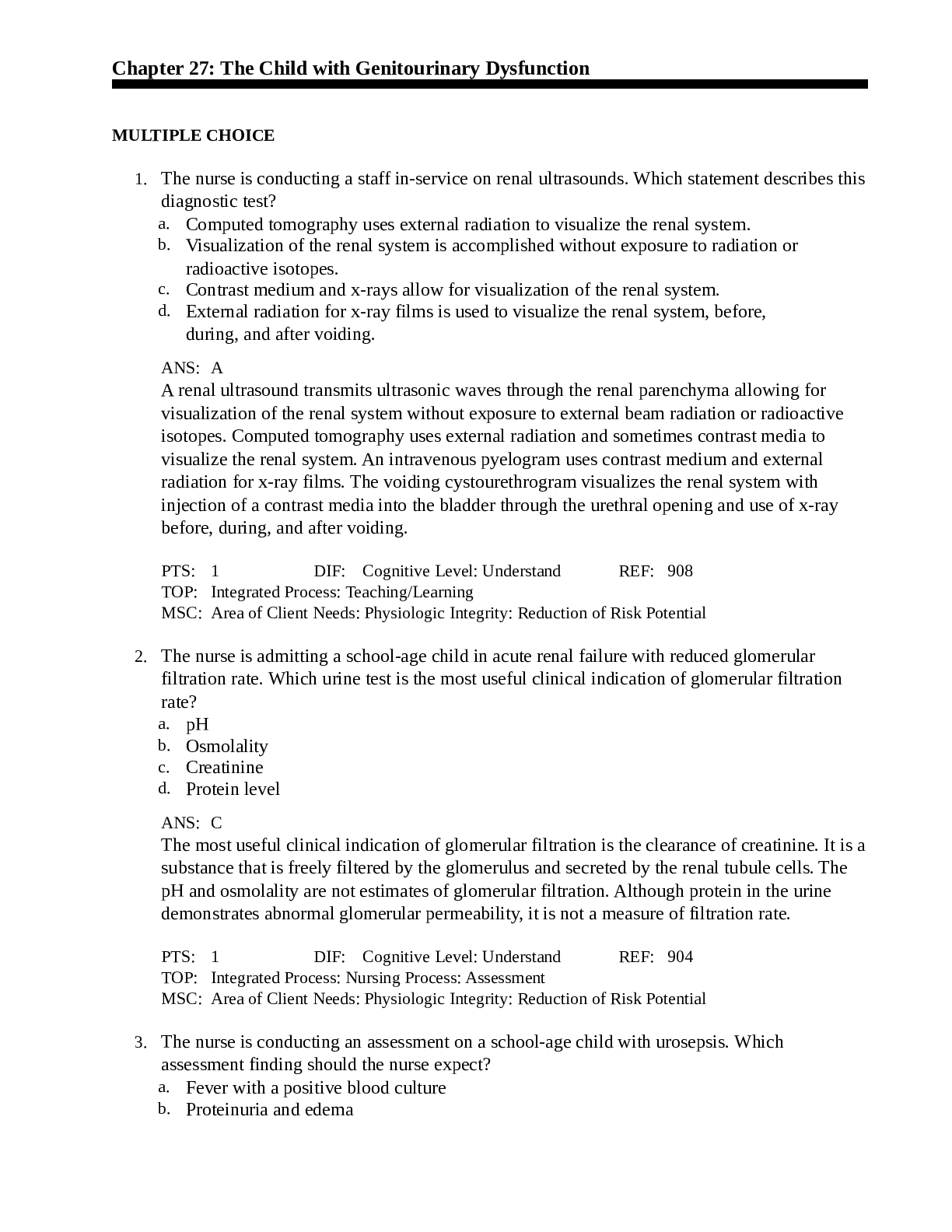
.png)



.png)

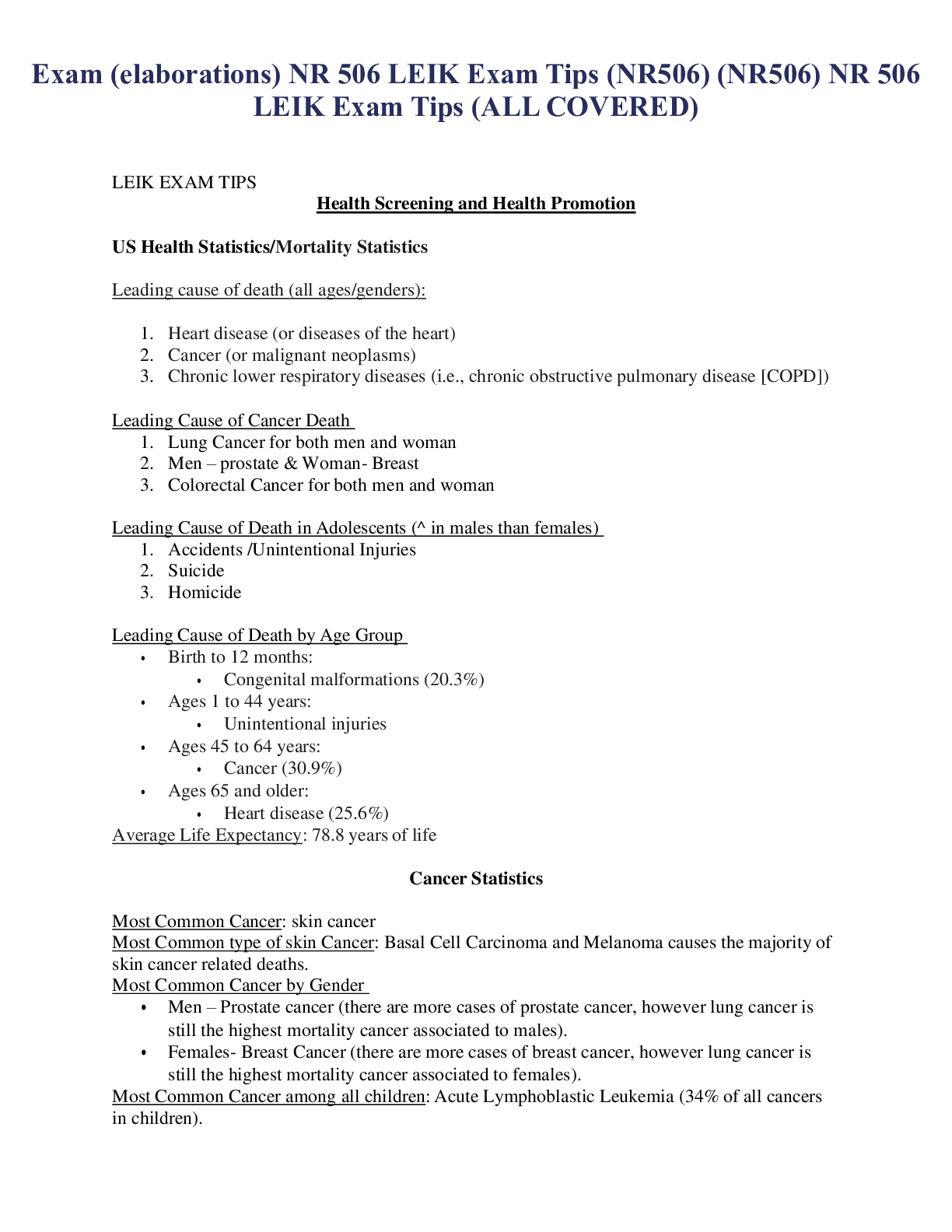


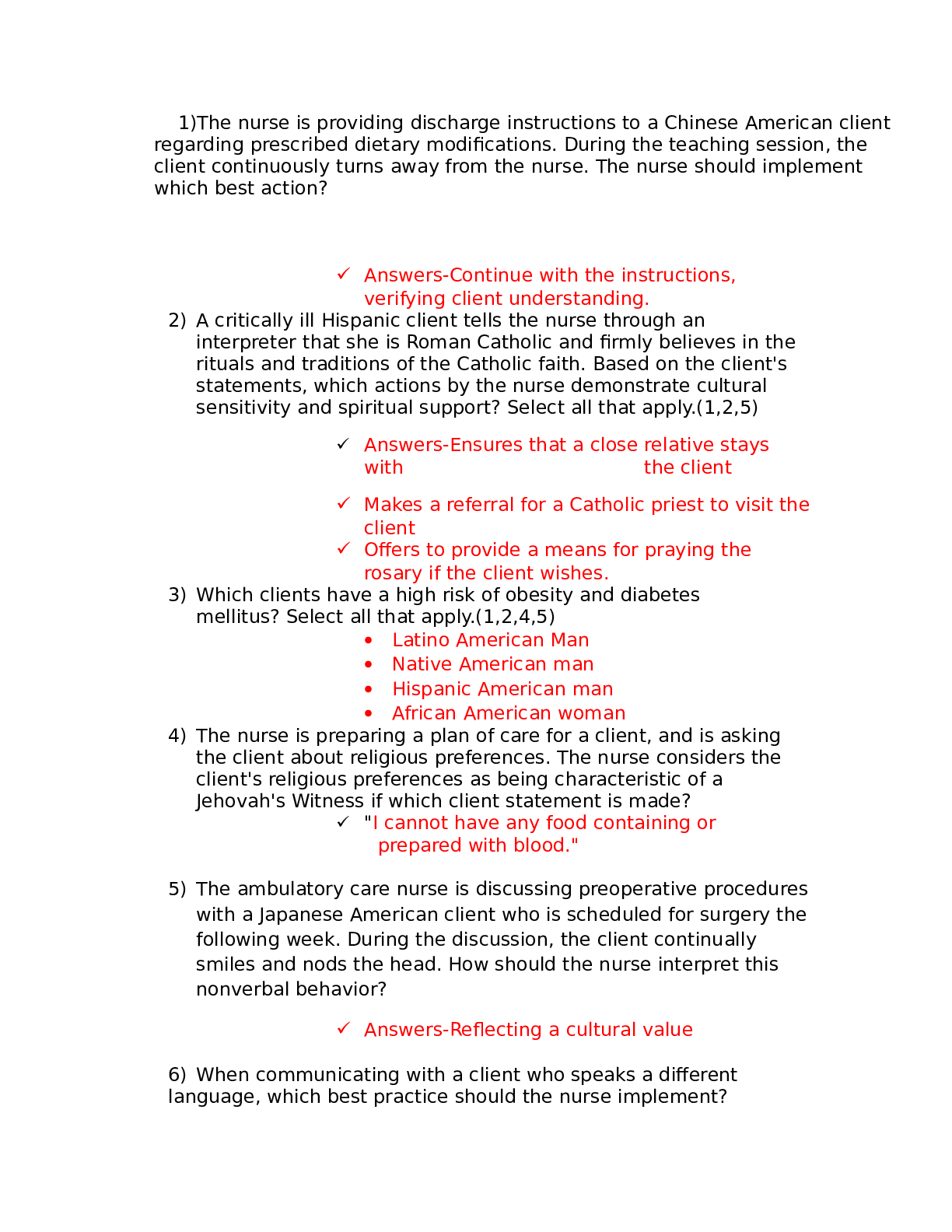
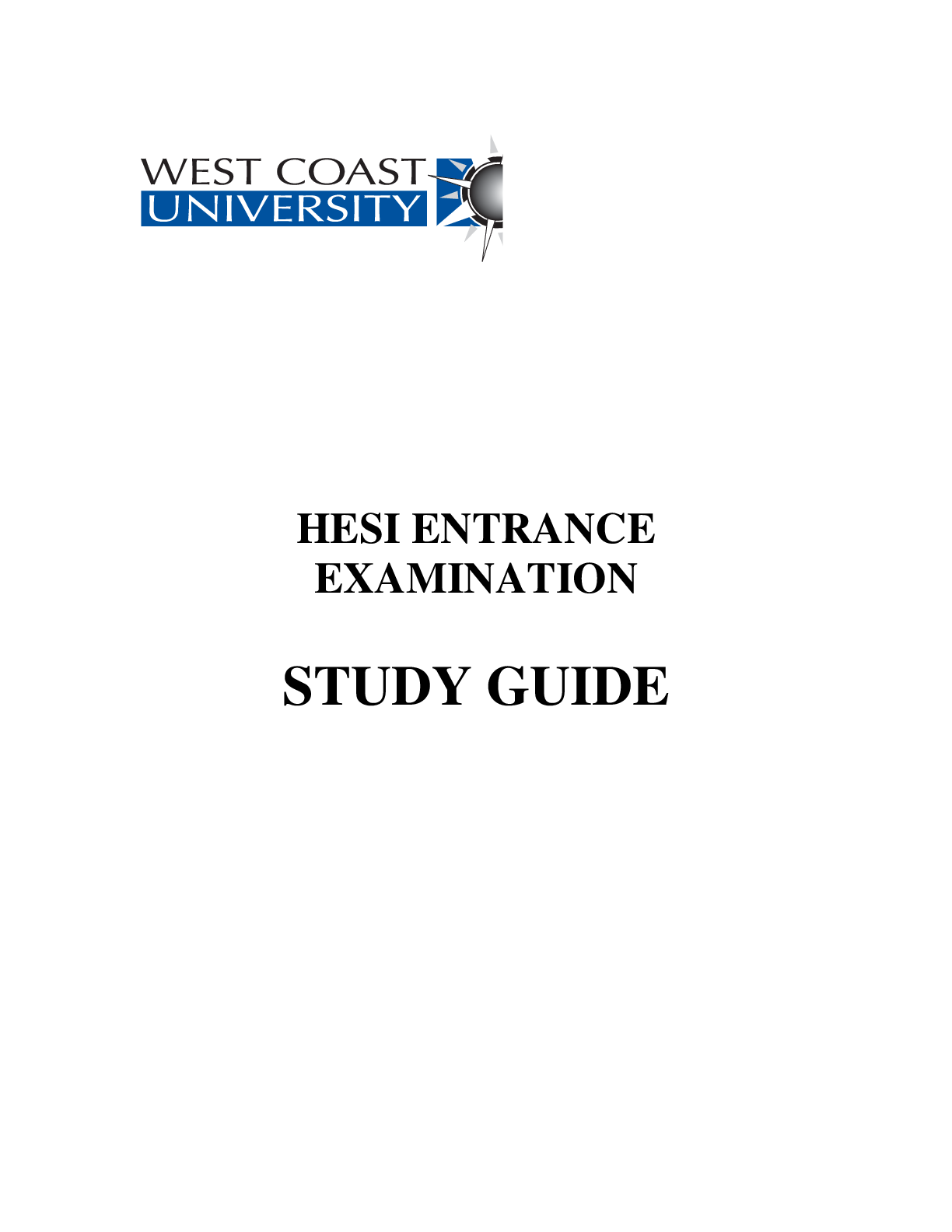
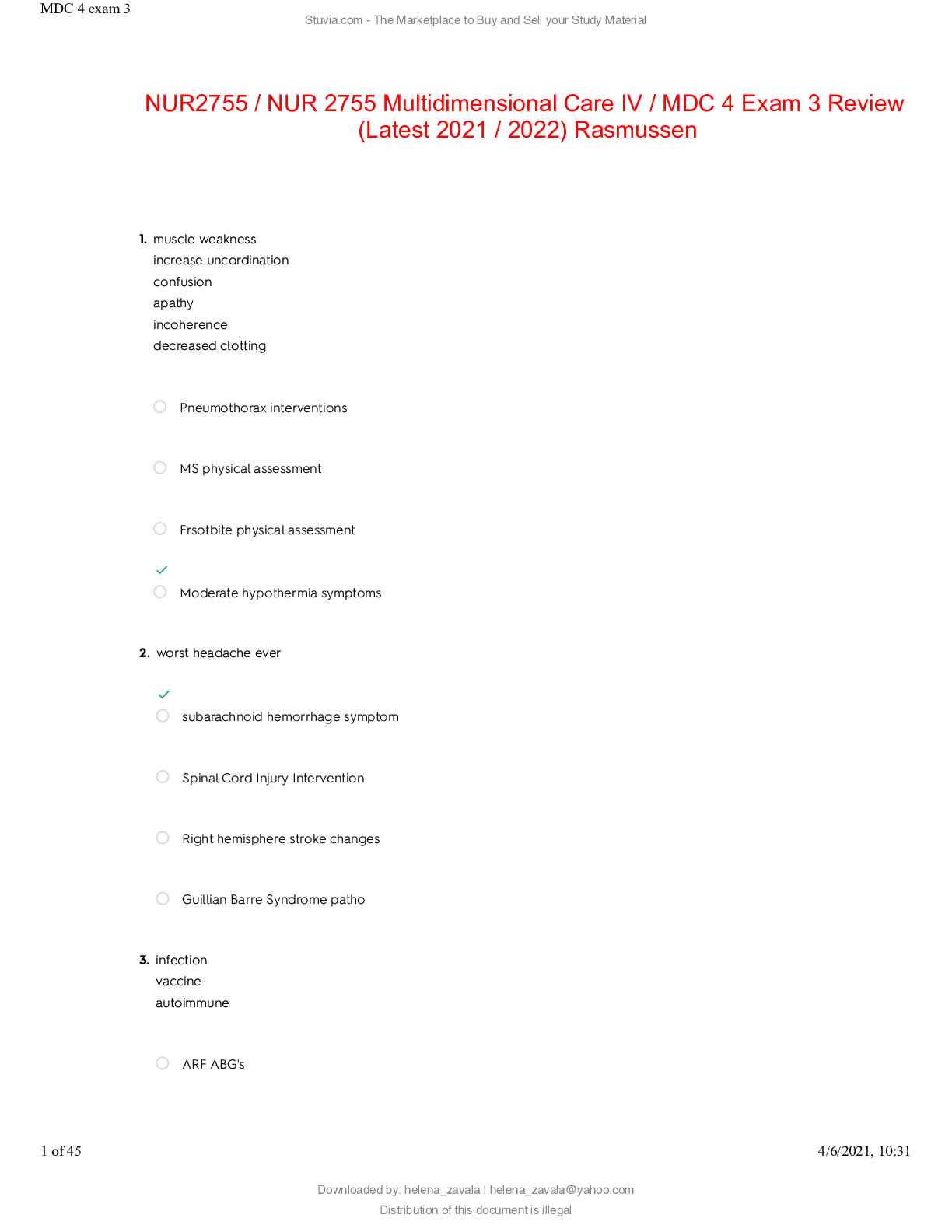


.png)


.png)


.png)


.png)
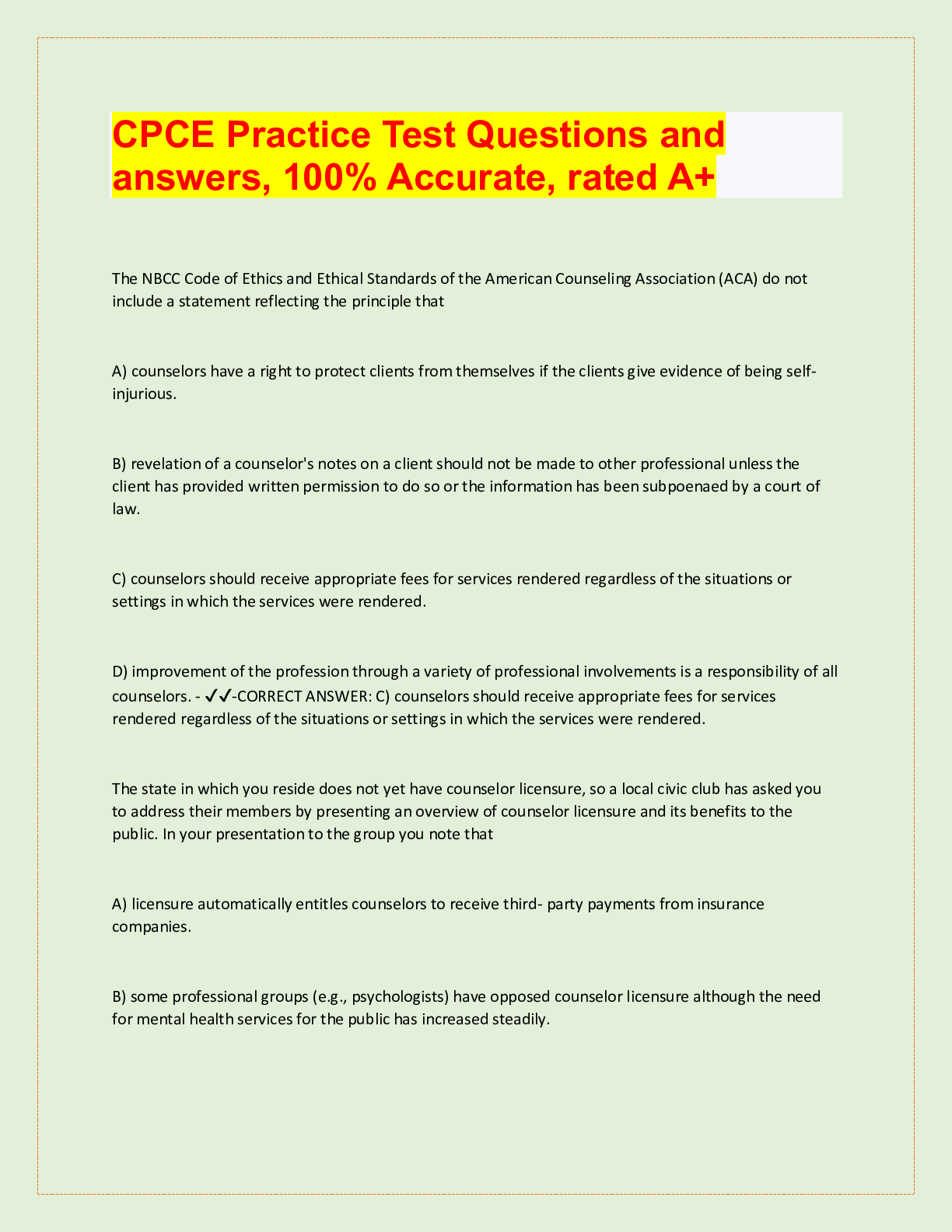
.png)
.png)
.png)

